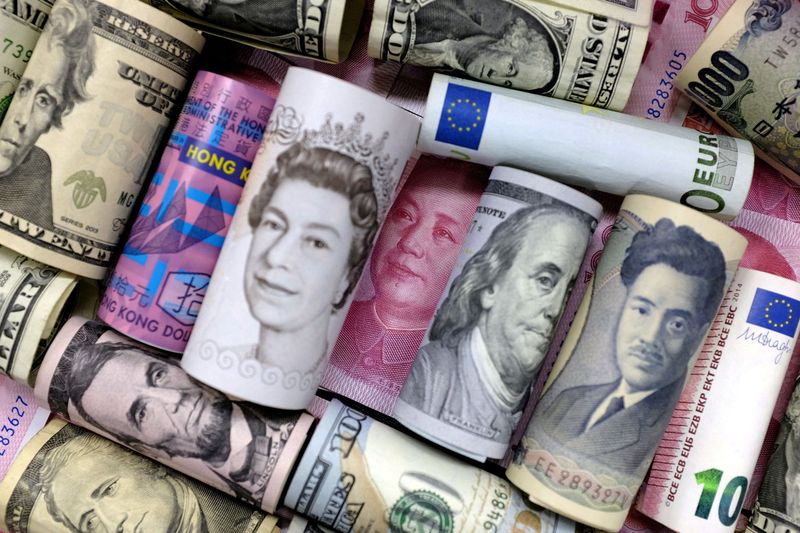 © Reuters. FILE PHOTO: Euro, Hong Kong dollar, U.S. dollar, Japanese yen, pound and Chinese 100 yuan banknotes are seen in this picture illustration, January 21, 2016. REUTERS/Jason Lee/Illustration/File Photo
© Reuters. FILE PHOTO: Euro, Hong Kong dollar, U.S. dollar, Japanese yen, pound and Chinese 100 yuan banknotes are seen in this picture illustration, January 21, 2016. REUTERS/Jason Lee/Illustration/File Photo
By Gertrude Chavez-Dreyfuss and Caroline Valetkevitch
NEW YORK (Reuters) -The safe-haven Japanese yen and Swiss franc climbed to two-week peaks against the U.S. dollar on Thursday, on worries about escalating Russia-Ukraine tensions that could have economic repercussions worldwide.
In afternoon trading, the dollar slid to 114.845 yen, the lowest since early February. It was last down 0.4% at 114.93 yen.
Against the Swiss currency, the greenback fell to 0.9189 francs, the weakest since Feb. 3. The dollar last changed hands at 0.9202 francs, down 0.2%.
"Safe havens are outperforming as today's geopolitical development dampened hopes for a diplomatic deal to avert military action around Ukraine," said Joe Manimbo, senior market analyst, at Western Union (NYSE:WU) Business Solutions in Washington.
U.S. President Joe Biden said on Thursday there was now every indication Russia was planning to invade Ukraine in the next few days and preparing a pretext to justify it, after Ukrainian forces and pro-Moscow rebels traded fire in eastern Ukraine.
Russia also accused Biden of fueling tension and released a strongly worded letter that said Washington was ignoring its security demands and threatened unspecified "military-technical measures."
Fears of a Russia invasion pushed U.S. stocks sharply lower and spurred bids for safe-haven Treasuries. [US/]
For now, the Russia-Ukraine conflict has superseded concerns about the Federal Reserve's plans to tighten monetary policy, starting at the March meeting of the Federal Open Market Committee. But the market has been divided over the size of the expected interest rate increase.
Last week, with the latest U.S. consumer prices data showing the largest annual gain in 40 years, rate futures market had priced in a roughly 70% chance of a half-percentage rate rise in March. That has come down to 37% on Thursday,
The more likely scenario is for a quarter-point tightening by the Fed, analysts said.
But even with the Fed's hawkish shift, the dollar has remained broadly unchanged.
"We think this is largely because other central banks' hawkish shifts have also pushed up the yields of long-dated government bonds in other developed markets, resulting in a smaller shift in relative yields," said Jonathan Petersen, markets economist, at Capital Economics.
The dollar index, a measure of its value against six major currencies, has gained just 0.2% so far this year. Against the yen, however, the greenback has been down 0.2% so far in 2022.
U.S. Treasury 2-year yields, which reflect rate expectations and are correlated with dollar/yen, have surged about 74 basis points.
In afternoon trading, the dollar index was flat at 95.827.
Some commodity currencies, which are sensitive to risk sentiment, fell, with the Australian dollar falling 0.1% to US$0.7188. The Norwegian crown dropped as well against the dollar, which rose 0.5% to 8.917.
In cryptocurrencies, bitcoin, which moves in tandem with other risk assets, was last down 7.8% at $40,590.
========================================================
Currency bid prices at 4:19PM (2119 GMT)
Description RIC Last U.S. Close Pct Change YTD Pct High Bid Low Bid
Previous Change
Session
Dollar index 95.8200 95.8260 +0.00% 0.164% +96.1090 +95.6980
Euro/Dollar $1.1360 $1.1373 -0.11% -0.07% +$1.1386 +$1.1323
Dollar/Yen 114.9300 115.4500 -0.45% -0.16% +115.5350 +114.8450
Euro/Yen 130.56 131.30 -0.56% +0.18% +131.4900 +130.4100
Dollar/Swiss 0.9204 0.9222 -0.21% +0.89% +0.9229 +0.9190
Sterling/Dollar $1.3616 $1.3583 +0.25% +0.69% +$1.3638 +$1.3557
Dollar/Canadian 1.2705 1.2694 +0.10% +0.49% +1.2734 +1.2675
Aussie/Dollar $0.7187 $0.7197 -0.11% -1.10% +$0.7217 +$0.7151
Euro/Swiss 1.0456 1.0486 -0.29% +0.84% +1.0495 +1.0449
Euro/Sterling 0.8341 0.8368 -0.32% -0.70% +0.8379 +0.8335
NZ $0.6689 $0.6680 +0.18% -2.23% +$0.6717 +$0.6660
Dollar/Dollar
Dollar/Norway 8.9165 8.8820 +0.45% +1.28% +8.9345 +8.8785
Euro/Norway 10.1311 10.0904 +0.40% +1.18% +10.1516 +10.0903
Dollar/Sweden 9.3380 9.2719 +0.57% +3.56% +9.3760 +9.2683
Euro/Sweden 10.6075 10.5479 +0.57% +3.67% +10.6541 +10.5480

